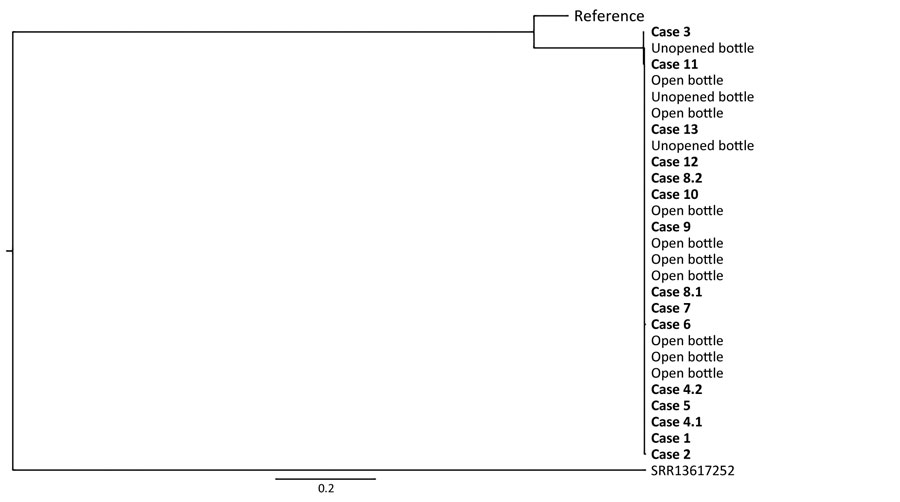Community Outbreak of Pseudomonas aeruginosa Infections Associated with Contaminated Piercing Aftercare Solution, Australia, 2021
Benjamin T. Trevitt

, Anthea L. Katelaris, Catherine Bateman-Steel, Sandra Chaverot, Sinead Flanigan, Toni Cains, Elena Martinez, Andrew Ginn, Vitali Sintchenko, Arthur Jones, Kishen Lachireddy, Mark J. Ferson, and Vicky Sheppeard
Author affiliations: South Eastern Sydney Public Health Unit, Sydney, New South Wales, Australia (B.T. Trevitt, A.L. Katelaris, C. Bateman-Steel, S. Chaverot, S. Flanigan, T. Cains, M.J. Ferson, V. Sheppeard); University of Sydney, Sydney (B.T. Trevitt, E. Martinez, A. Ginn, V. Sintchenko, V. Sheppeard); Institute for Clinical Pathology and Medical Research New South Wales Health Pathology, Sydney (E. Martinez, A. Ginn, V. Sintchenko); St George Hospital, Sydney (A. Jones); Health Protection NSW, Sydney (K. Lachireddy); University of New South Wales, Sydney (M.J. Ferson)
Main Article
Figure 2

Figure 2. Phylogenetic analysis of Pseudomonas aeruginosa isolates collected in New South Wales in study of community outbreak of P. aeruginosa infections associated with contaminated piercing aftercare solution, Australia, 2021. Whole-genome sequencing was performed, and single-nucleotide polymorphisms were identified for 27 P. aeruginosa isolates from clinical specimens and opened or unopened bottles of Protat aftercare solution (Protat Tattoo Supplies, https://www.protatsupplies.com.au). Cluster analysis showed that all 27 sequences were genomically linked and belonged to sequence type 988. Reference indicates a representative sequence type 988 obtained from GenBank that was included in the analysis for comparison. The branch marked SRR13617252 indicates the P. aeruginosa mapping reference genome from the National Center for Biotechnology Information Sequence Read Archive database (https://www.ncbi.nlm.nih.gov/sra). Scale bar indicates nucleotide substitutions per site.
Main Article
Page created: August 21, 2023
Page updated: September 20, 2023
Page reviewed: September 20, 2023
The conclusions, findings, and opinions expressed by authors contributing to this journal do not necessarily reflect the official position of the U.S. Department of Health and Human Services, the Public Health Service, the Centers for Disease Control and Prevention, or the authors' affiliated institutions. Use of trade names is for identification only and does not imply endorsement by any of the groups named above.
